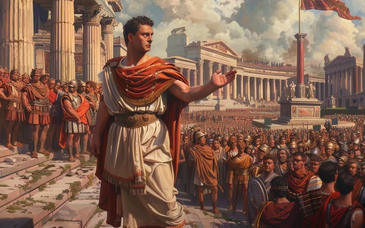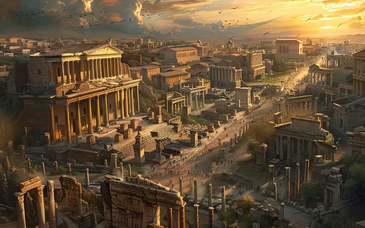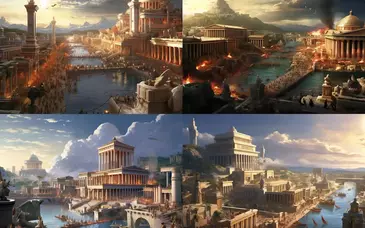The Punic Wars is the generally used term for the lengthy conflict between the two main centres of power in the western Mediterranean, Rome and Carthage. Carthage was originally a Phoenician colony. The Latin name for a Phoenician is 'Poenus' which leads to our English adjective 'Punic'.
Carthage
The First Punic War begun almost accidentally but it was to be a hard struggle, and the result was long doubtful.
In the first three years (264-261 BC) the Romans captured the great fortress of Acragas, which they called Agrigentum, still the next city of in Sicily after Syracuse, and confined the Carthaginian forces to the rugged western districts around their own ports. But by resigning territory Carthage simplified the problems of defence on land, and was able to raid not only Greek coast cities, but also the long Roman lines of communication, which were mostly within reach of the sea. For this state of things there was but one remedy. If Rome was to win, Rome had to have a fleet. And in the second stage of the war (260-253 BC) not only was this accomplished, with liberal help from Greek naval allies organized on a grand scale, but in spite of early defeats, and other disasters due to Roman inexperience, the traditional seamanship of the Carthaginians was foiled by mechanical devices for bringing their ships to a standstill and so fighting a land battle on water.
The Romans built entire fleets to match the Carthaginian numbers and crewed them with marine commandos trained in hand-to-hand fighting. It the age of only such rudimentary artillery such as catapults the usual naval tactic was to attach grapples to an enemy ship and then overwhelm the opposition with superior numbers.
The losses on both sides were enormous. The Romans, however, managed to commit ever more resources into the struggle.
In 256 BC the destruction of the Carthaginian 'grand fleet' off Heraclea on the south coast of Sicily by a Roman squadron, encumbered though it was with a convoy of transports, laid open the way to Africa. Here the natives rose against their masters, as they had risen for Agathocles, and the Roman force advanced within sight of Carthage. At this point peace might have been made. But the Roman commander Regulus demanded too much. The Carthaginians found in the Lacedaemonian adventurer Xanthippus a soldier of genius to reorganize and lead their forces. Regulus was defeated and captured and the survivors off the onslaught on land were wrecked on their homeward journey.
Rome's first African venture had failed (255 BC).
Carthage however had suffered severely in prestige as well as equipment, and might have suffered worse had not the next year's Roman fleet been wrecked on its way to Africa (253 BC), with the result that for a while only coast defence squadrons were in commission, and Roman commanders concentrated their resources on the reduction of enemy fortresses in Sicily.
By 250 BC only Lilybaeum and a new naval base at Drepanum remained untaken, and it became clear once more that these remote ports might hold out indefinitely, if the Romans could not blockade them also by sea. Again Carthage tried to compromise, but her overtures were flatly rejected.
The established Roman tradition affirms that the rejection was due to the action of the captive consul Regulus, and the story, wether true or not, has set him among the heroic figures of the world. For five years he had been held prisoner by the Carthaginians. Now they sent him with their embassy to Rome, under parole (parole= word of honour not to escape), never doubting that all his powerful influence would be exerted in favour of liberty.
Nevertheless, so runs the tale, with no illusions as to the cruel fate which awaited him, he set aside all thought of self, and advised the Romans to take no thought of him, and urged them to refuse the offered terms. He might easily have broken his parole and remained at Rome a free man, but his high sense of honour stopped him from doing so, and he returned to Carthage with the disappointed and angry ambassadors, there to suffer a barbarous death at the hands of his vindictive captors. But at Rome the memory of him was cherished and revered, as the supreme example of Roman courage, to which Rome loved to think that she owed her greatness.
So Rome resolved to see the war to a satisfactory end and began building ships again, and training crews and admirals in naval skills.
At this stage it was a serious disappointment that in renewing their treaty with Hiero in 248 BC they had to forgo the Syracusan tribute. Sicily was, indeed, nearly ruined by the long war, and in particular by the cost of great sieges at the distant west end. Henceforward the cost of these operations and of the renewal of the fleets feel principally on the Romans themselves, while any trade they had had was paralyzed by Carthaginian cruisers, which ranged as far north as the coast of Latium.
A fourth stage of the war opens in 247 BC with the appearance of a Carthaginian commander, Hamilcar Barca, well worthy of the honorary name (Barca, or Barak, means 'lightning') that he bore.
But vigorous privateering and by establishing fresh raiding ports at Ercte and Eryx, he prolonged the desperate resistance of the blockaded fortresses, and all but exhausted Rome's resources and determination.
Finally in 242 BC, the perilous experiment of naval action was adopted once more by the senate. The new fleet was built with private subscriptions, but it was well found, and at least efficiently handled. Its sole commission was to cut off supplied from the Sicilian fortresses, and in this it was not only succeeded, but had the good luck to intercept and destroy the last ill escorted convoy that Carthage was able to send. The Carthaginian government could do no more. There were native revolts in Africa and mercenaries will not fight long without pay. Hamilcar was prepared to persist, but was induced at last to conduct the negotiations himself.
The Roman terms were severe. Carthage was to evacuate Sicily and surrender it to Rome, with all adjacent islands, to restore prisoners and deserters, to pay an immense indemnity spread over ten years and to promise not to make war in future against Hiero or his allies. Hiero's territory was enlarged, and his independence as an ally of Rome guaranteed. Messana and a few other cities were received likewise into 'free' and equal alliance. But the rest of Sicily remained in Roman hands as conquered territory, administered by a resident governor and chief justice, sent annually from Rome, and paying Rome a tribute on all produce, and harbour duties on all imports and exports. (241 BC).



